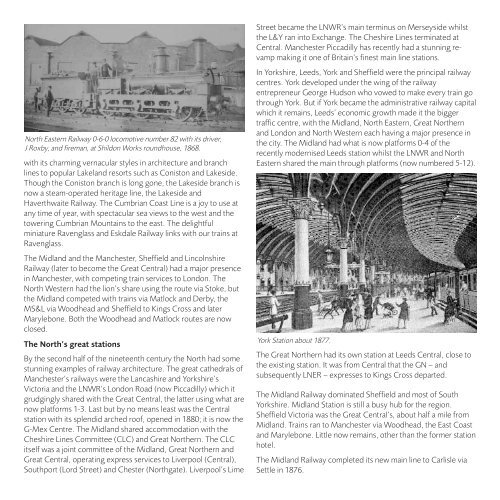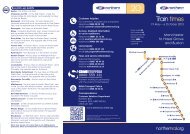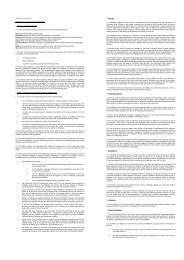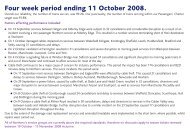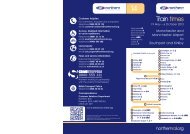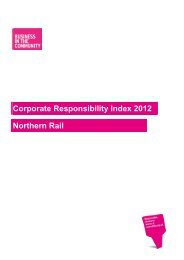Northern Heritage - Northern Rail
Northern Heritage - Northern Rail
Northern Heritage - Northern Rail
- No tags were found...
You also want an ePaper? Increase the reach of your titles
YUMPU automatically turns print PDFs into web optimized ePapers that Google loves.
North Eastern <strong>Rail</strong>way 0-6-0 locomotive number 82 with its driver,J Roxby, and fireman, at Shildon Works roundhouse, 1868.with its charming vernacular styles in architecture and branchlines to popular Lakeland resorts such as Coniston and Lakeside.Though the Coniston branch is long gone, the Lakeside branch isnow a steam-operated heritage line, the Lakeside andHaverthwaite <strong>Rail</strong>way. The Cumbrian Coast Line is a joy to use atany time of year, with spectacular sea views to the west and thetowering Cumbrian Mountains to the east. The delightfulminiature Ravenglass and Eskdale <strong>Rail</strong>way links with our trains atRavenglass.The Midland and the Manchester, Sheffield and Lincolnshire<strong>Rail</strong>way (later to become the Great Central) had a major presencein Manchester, with competing train services to London. TheNorth Western had the lion’s share using the route via Stoke, butthe Midland competed with trains via Matlock and Derby, theMS&L via Woodhead and Sheffield to Kings Cross and laterMarylebone. Both the Woodhead and Matlock routes are nowclosed.The North’s great stationsBy the second half of the nineteenth century the North had somestunning examples of railway architecture. The great cathedrals ofManchester’s railways were the Lancashire and Yorkshire’sVictoria and the LNWR’s London Road (now Piccadilly) which itgrudgingly shared with the Great Central, the latter using what arenow platforms 1-3. Last but by no means least was the Centralstation with its splendid arched roof, opened in 1880; it is now theG-Mex Centre. The Midland shared accommodation with theCheshire Lines Committee (CLC) and Great <strong>Northern</strong>. The CLCitself was a joint committee of the Midland, Great <strong>Northern</strong> andGreat Central, operating express services to Liverpool (Central),Southport (Lord Street) and Chester (Northgate). Liverpool’s LimeStreet became the LNWR’s main terminus on Merseyside whilstthe L&Y ran into Exchange. The Cheshire Lines terminated atCentral. Manchester Piccadilly has recently had a stunning revampmaking it one of Britain’s finest main line stations.In Yorkshire, Leeds, York and Sheffield were the principal railwaycentres. York developed under the wing of the railwayentrepreneur George Hudson who vowed to make every train gothrough York. But if York became the administrative railway capitalwhich it remains, Leeds’ economic growth made it the biggertraffic centre, with the Midland, North Eastern, Great <strong>Northern</strong>and London and North Western each having a major presence inthe city. The Midland had what is now platforms 0-4 of therecently modernised Leeds station whilst the LNWR and NorthEastern shared the main through platforms (now numbered 5-12).York Station about 1877.The Great <strong>Northern</strong> had its own station at Leeds Central, close tothe existing station. It was from Central that the GN – andsubsequently LNER – expresses to Kings Cross departed.The Midland <strong>Rail</strong>way dominated Sheffield and most of SouthYorkshire. Midland Station is still a busy hub for the region.Sheffield Victoria was the Great Central’s, about half a mile fromMidland. Trains ran to Manchester via Woodhead, the East Coastand Marylebone. Little now remains, other than the former stationhotel.The Midland <strong>Rail</strong>way completed its new main line to Carlisle viaSettle in 1876.


